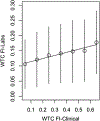Development and Validation of a Clinical Frailty Index for the World Trade Center General Responder Cohort
- PMID: 33706594
- PMCID: PMC9561755
- DOI: 10.1177/0898264321997675
Development and Validation of a Clinical Frailty Index for the World Trade Center General Responder Cohort
Abstract
Objectives: To develop and validate a clinical frailty index to characterize aging among responders to the 9/11 World Trade Center (WTC) attacks. Methods: This study was conducted on health monitoring data on a sample of 6197 responders. A clinical frailty index, WTC FI-Clinical, was developed according to the cumulative deficit model of frailty. The validity of the resulting index was assessed using all-cause mortality as an endpoint. Its association with various cohort characteristics was evaluated. Results: The sample's median age was 51 years. Thirty items were selected for inclusion in the index. It showed a strong correlation with age, as well as significant adjusted associations with mortality, 9/11 exposure severity, sex, race, pre-9/11 occupation, education, and smoking status. Discussion: The WTC FI-Clinical highlights effects of certain risk factors on aging within the 9/11 responder cohort. It will serve as a useful instrument for monitoring and tracking frailty within this cohort.
Keywords: 9/11 responders; World Trade Center cohort; frailty index.
Conflict of interest statement
Declaration of Conflicting Interests
The author(s) declared no potential conflicts of interest with respect to the research, authorship, and/or publication of this article.
Figures






References
-
- Bello G, Chiu Y, & Dumancas G (2019). Association of a biomarker-based frailty index with telomere length in older American adults: Findings from the National Health and Nutrition Examination Survey 1999 – 2002. EMJ Innovations, 3(1), 73–81.
-
- Bello GA, Teitelbaum SL, Lucchini RG, Dasaro CR, Shapiro M, Kaplan JR, Crane MA, Harrison DJ, Luft BJ, Moline JM, Udasin IG, & Todd AC (2017). Assessment of cumulative health risk in the World Trade Center general responder cohort. American Journal of Industrial Medicine, 61(1), 63–76. - PubMed
Publication types
MeSH terms
Grants and funding
LinkOut - more resources
Full Text Sources
Other Literature Sources

